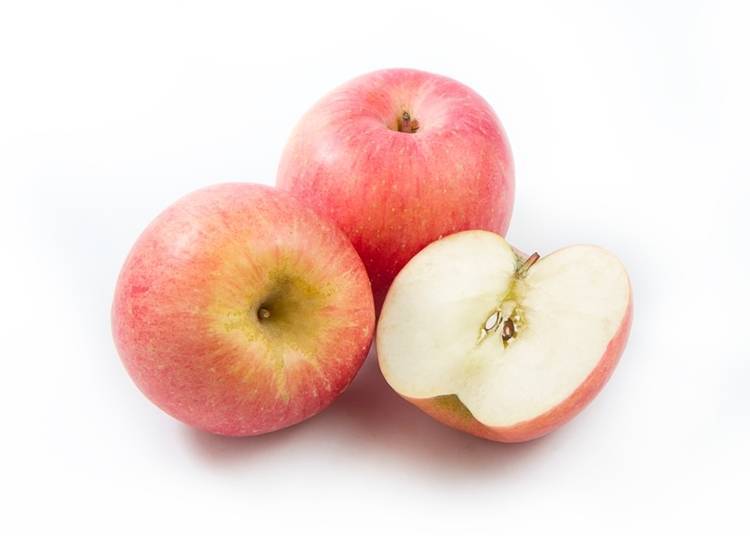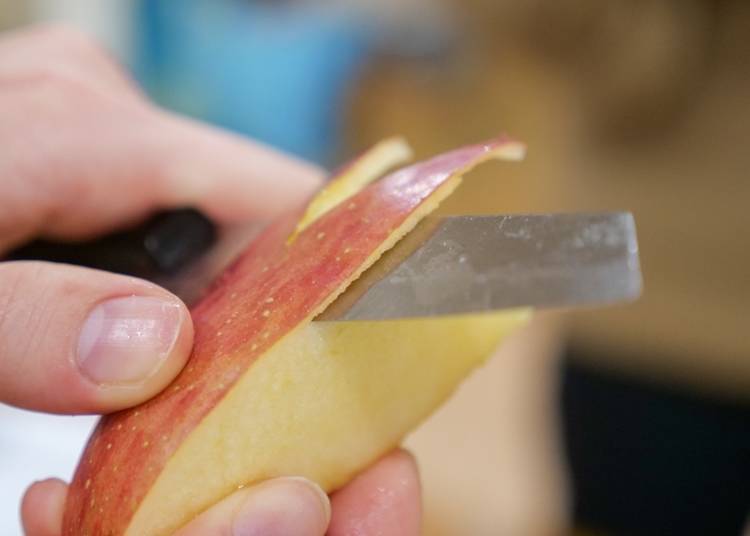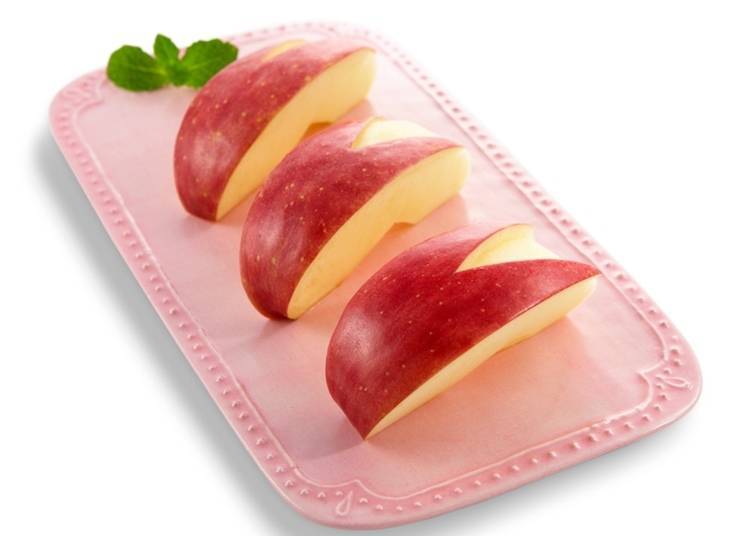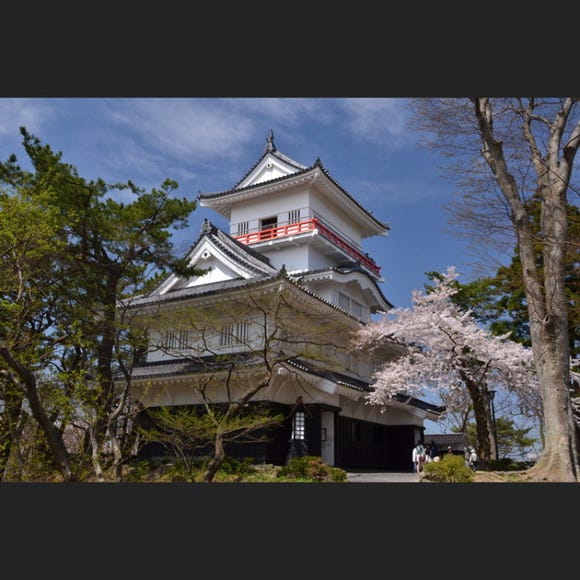
Do you like apples? Found all over the world, they’re nutritious and delicious! In Japan, apples are highly regarded as popular gifts.
Saika from Aomori Prefecture’s agricultural revitalization pop group “RINGOMUSUME” talked to the Aomori Prefecture Apple Association about the types of world-class Japanese apples and their characteristics, demonstrates how to easily peel them, and recommends some of her favorite apple dishes.

Five major varieties of Japanese apples
The first thing that will catch your attention about Japanese apples is their size. In Europe and the United States, apples are typically baseball-sized, but those found in Japanese supermarkets are noticeably larger and flawless.
There are various theories about this, but the quality and appearance of the apples certainly is influenced by the Japanese spirit of high-quality craftsmanship and production.
Differences in food culture also play a part. Japanese people often share fruit among multiple people, whereas Europeans and Americans want a filling individual portion.


Except in Okinawa, Japanese apples are grown nationwide, but the main apple-producing area is Aomori Prefecture, accounting for more than half of domestic production, followed by Nagano and Iwate prefectures in the Koshinetsu and Tohoku regions, respectively.
Hirosaki City in Aomori is actually surrounded by orchards, and the sight of countless apples in the vast fields is a welcome scene each autumn.

There are about 60 main varieties of apples currently on the market in Japan, and when considering variations, that number jumps to about 2,400.
There are four major types, with about 50% of the apple yield coming from the “Fuji” variety, followed by “Tsugaru,” “Orin,” and “Jonagold” at 10% each, and other varieties at about 20%.
Here’s an introduction to some Japanese apple varieties you should pay attention to!

1. Fuji
Fuji apples have both overwhelming popularity and high production volume. The harvest season is from late October to early November, and they are juicy with a very good balance of sweetness and tartness. Red, with a crispy texture, Fuji apples also have an excellent shelf life and can be found in supermarkets throughout the year.

2. Jonagold
Jonagolds, characterized by their crispy texture, are also popular. Developed in New York, USA, these bright red apples have a sticky surface that becomes “greasy” when ripe. The harvest season is mid-October, and their tart flavor makes them suitable for cooking and use in sweets.

Orin
Yellow Orin are popular overseas. Their name means “the king of apples,” and they are satisfying to eat with their bold sweetness and mellow scent. Sweet yellow varieties are extremely rare in the world, making Orin apples very popular in Hong Kong, for example. The Orin harvest season is early November, and they are mainly produced in Aomori and Nagano prefectures.

4. Toki
Toki is one of the best-selling yellow apples, second only to Orin. A cross between Orin and Fuji, Toki have been called “thoroughbred” apples. Characterized by their crispy texture and outstanding sweetness, they also have a slightly tart accent. Harvested in early October, Toki apples are especially popular in Taiwan.

5. Saika
Finally, Saika, the author’s namesake. A rare variety with an early harvest time – in late September – these juicy, delicious apples have just the right balance of sweetness tartness. The name “Saika” is applied only to fresh fruits, while saplings and processed products are called “Aori 9.”

By the way, we RINGOMUSUME members have stage names chosen from apple varieties, and there are currently four of us, with the names “Toki,” “Orin,” “Jonagold,” and “Saika.”
We promote Japanese apples through song and dance performances, so please take this opportunity to remember these types of apples!
How do you choose the most delicious apples? Pay attention to the stems and bottoms
All Japanese apples are big and juicy, but how do you find a particularly delicious one? The keys are the stem and the bottom of the apple! The stem not only connects an apple to the branch, but also brings nutrients to the fruit.
The freshest stems are long and straight, and thicker, firmer ones are a sign of a delicious apple, so be sure to take a close look at the stems.

It is also important to check the color of the apple, that is, whether the “base color” is missing, by looking at the bottom of the apple.
It’s easy to see which apples are red, but reflective sheets are sometimes used to enhance the coloring of Japanese apples, so it can be difficult to judge whether they are really ripe in the middle. So, choose one that has lost its greenish base color and which has a clear candy-colored skin.

However, early-harvest varieties such as Tsugaru and Saika become too soft and lose their crispness when they ripen as long as other apples. With that in mind, early-maturing apples should be slightly greenish at the bottom to ensure the best taste and texture.
Be sure to keep these tips in mind when buying apples at supermarkets!
How do you peel an apple like Japanese do? Making a 'rabbit' is easy!
Since Japanese apples are large, it is common to cut and share them instead of eating a whole one by yourself. To peel an apple, start by cutting it into 4 or 8 equal parts, then make a V-shaped cut toward the center to remove the seeds.

When peeling, support the apple piece with the thumb of your knife hand and slowly peel while adjusting the pressure of the blade. With practice, you’ll be able to keep the cut very thin.


Now, let’s make some decorative apple slices that even beginners can handle. As before, after cutting 4 or 8 pieces, turn the apple skin-side up and make a V-shaped cut in the skin toward the center on the left and right. It’s easier if you use the base of the blade.

Then peel toward the middle, starting from where you made the V-shaped cut. The part of the skin inside the V-cut should be removed.

Now you have a cute rabbit-shaped apple slice! Rabbit apples, which are very popular with children, are often found on dining tables and in lunch boxes in Japan. Keep in mind that if the skin is thin, the rabbit’s ears will not stand up, so be sure to peel a little thicker.


For those who say, “Cutting apples is a little annoying” or “I don’t like getting my hands sticky,” I recommend the convenient “Apple Cutter,” which allows you to cut apples without using a kitchen knife.
Simply place it on top of an apple and press downwards. The core will be removed and you will have eight perfectly equal apple slices. You can easily find apple cutters at 100-yen shops and other stores, so try one out!


Some recommended Japanese apple sweets and dishes
Apples are delicious raw, but they’re also great when processed. Here are some apple sweets and dishes I would like to recommend.
1. Apple Pie
First and foremost – apple pie – a magnificent combination of crisp pie crust, sweet and juicy apples, and an irresistible buttery scent. Many Japanese apples have a strong combination of tartness and sweetness, so it’s a good idea to get seasonal varieties and enjoy the difference in taste.

2. Baked Apples
My favorite way to eat apples – baked! This confectionery uses whole apples with a hollowed core stuffed with butter and sugar. The still-crisp, moderately thick apples are exquisitely delicious! Hot baked apples with cold vanilla ice cream is simply blissful!

3. Apple Salad / Yogurt
I also recommend adding sliced or diced apples to salads or yogurt. There is no doubt that the texture and flavor will make your meal even more enjoyable.

Japanese apples are high quality and there are many varieties, with different tastes, textures, appearances, and aromas, making it fun to sample and compare them.
In addition to being eaten raw, incorporating apples into cooked dishes and salads will add a wonderful taste and more color to your table. The next time you visit Japan, please try some delicious apples!
Interview cooperation: Aomori Apple Association
Text by: Saika (RINGOMUSUME)
Edited by: Tsubasa Shimoda
- Area
- Category
*Prices and options mentioned are subject to change.
*Unless stated otherwise, all prices include tax.
Popular Tours & Activitiess
Recommended places for you
-

Yokote Park
Parks
Surrounding Areas Of Akita
-

Baeren Brewery Co., Ltd.
Other Sightseeing
Morioka, Hiraizumi And Hachimantai
-

Lake Tazawa
Rivers, Lakes & Canyons
Surrounding Areas Of Akita
-

Jozenji Street
Other Townscapes
Sendai And Matsushima
-

Senshu Park
Parks
Surrounding Areas Of Akita
-

Sado Gold Mine
Winter
Niigata And Sado
-

Shopping in Akita: 11 Must-Buy Souvenirs & Where to Shop Near the Station and Airport
by: ShiroKu inc.
-

Smart Ways to Avoid Crowds and Enjoy a Safe, Comfortable Trip to Myoko, Niigata Prefecture.
-

Shopping in Niigata: 9 Must-Buy Souvenirs & Local Sake to Take Home
by: ShiroKu inc.
-

Aomori's Quiet Side in Autumn: 5 Scenic Spots in Hachinohe According to a Local
by: Marco Blasco
-

What to Buy in Aomori? 11 Aomori Souvenirs Locals Actually Recommend
by: ShiroKu inc.
-
Ad

Why Fukushima is the Next Big Food Destination in Japan The Foodie Paradise Only 90 Minutes from Tokyo
-

Where to Wine & Dine in Sendai - Northeastern Japan's Culinary Paradise!
by: Steve Csorgo
-

Tohoku Sake Secrets: Sendai Nihonshu Specialist Shares the Best Local Brews
-

Tokyo to Sendai: Riding the Shinkansen to Japan's Stunning Spots
-

Complete Guide to Buying Japanese Medicine in Japan: Phrases and Vocabulary You Need to Know
-

Visiting Japan's Miffy Cafe Will Make Your Heart Melt (Photos)
-

Sendai’s Iroha Yokocho: 3 Can't-Miss Sendai Restaurants for a Taste of Tohoku!












